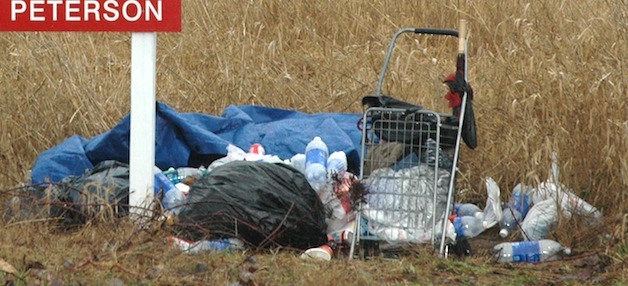SMOKEY POINT — Maybe you’ve seen her on the street and just not noticed her.
She sleeps on the side of Smokey Point Boulevard, near the intersection of 157th Street, covered in a tarp, and surrounded by so many empty bottles and plastic bags that she could be mistaken for a pile of garbage, rather than a human being.
She was the only homeless person Tami Krell and Ken Klein encountered during their three-hour shift, as part of the Snohomish County Point In Time Homeless Count Jan. 22. Because she refused to give her name, she couldn’t be officially counted, even though Krell spoke with her and knows she sleeps in that area often.
“She didn’t want to participate, because she was sleeping,” said Krell, who was coordinating the volunteers for north county that day. “There are places that people like her can go, but they’re often too intimidated to go there. The sudden structure can be very hard for them.”
Klein, a Snohomish County Council member, was on the Arlington City Council back when the city began making a concerted effort to deal with homelessness. He guided Krell to several sites in Smokey Point and Arlington where citizens had reported spotting homeless people. However, while they found plenty of evidence of homeless camps at several sites, there were no other people.
“The county’s way of addressing the situation is a different ballgame from the city,” Klein said. “We distribute many of the services that tie into this issue, and determine what funds are available for them, so we need to know what responses are most effective.”
That Krell and Klein only observed one homeless person could be regarded as positive news, except Krell pointed out that many factors make it difficult to count how many really are homeless.
“We have to get the first two initials of their first and last names, plus their birthdays, or we can’t count them,” said Krell, who also expressed concerns with conducting the count during one of the coldest months of the year. “If our numbers are lower, are we really handling the homeless problem, or are we redefining it?”
Further complicating the count this year was an instruction from the Office of Superintendent of Public Instruction.
Scott Irwin, director of categorial programs for the Marysville School District, joined Andrea Conley, public information coordinator for the Arlington School District, and Dale Leach, homeless liaison for the Lakewood School District, in confirming that OSPI allows schools to provide their total numbers of homeless students for the Point In Time count, but not any individual names or identifying information.
Conley added: “They were asking specific questions we don’t feel comfortable answering.
Leach elaborated that OSPI allowed the districts to “help in any way that doesn’t violate the laws, but we need to protect students’ privacy.”
Krell sympathizes with the districts’ need to ensure their students’ confidentiality, but laments its effect on the Point In Time count nonetheless.
“It’s amazing how we can see the signs of homelessness every day, and yet, the day we do this count, we can go a whole shift where there are no homeless to be found,” Krell said.







